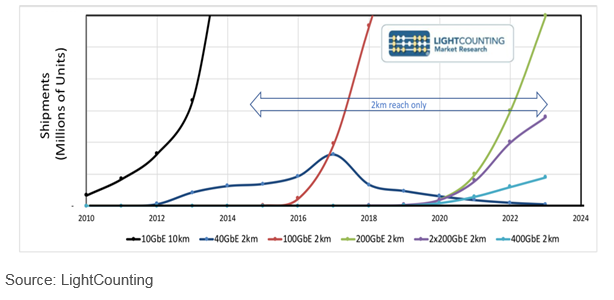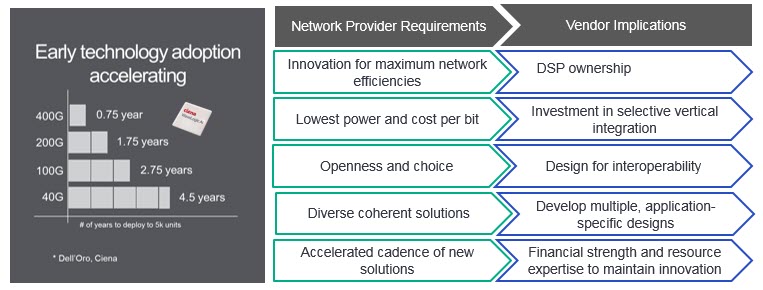Pluggables: Their role in coherent technology evolution
Pluggable client optics
In the optical networking industry, pluggable client optical modules are a dominant trend for very short links within buildings and campus networks. Market economics that have driven the proliferation of these pluggables include factors such as simplicity, interoperability and volume-driven cost. And in the domain of short-reach (sub-10km), point-to-point fiber optic connections, the advantages listed above for using small form-factor, pluggable modules shine through.
This is particularly so in the case where transport of high-speed Ethernet client signals is the primary requirement. Connectivity within and between data centers has grown at a very rapid rate over the last few years, both from the perspective of transmission speed and number of connections. The use of optical signaling to transport these high-speed Ethernet signals has proven to be very efficient.

Figure 1: Shipment forecast for short-reach, high-speed Ethernet client optics
The pluggable wave
The optical networking industry has a well-established and large ecosystem of vendors bringing small form-factor client modules to market. Many of these are supported by MSAs (Multi-Source Agreements) which can be one of two types; those that define optical transmission specifications and those that define mechanical forms.
The form factor MSAs define a compact mechanical module type that is connectorized and, therefore, pluggable into a compatible socket in a system platform which could be a router or an optical transport line system. The mechanical MSAs are typically planned to support both industry optical transmission MSAs as well as high-speed Ethernet transmission standards defined by the IEEE.
With most MSA groups sporting a membership of multiple companies, the benefit for end-users is security of supply and, usually, a guarantee of interoperability that eases supply chain management.
Pluggable capacity is growing
More recently, the data rates supported by pluggable form factors have increased. The 100G Lambda MSA group, of which Ciena is a member, has exhibited live demonstrations of interoperable Ethernet modules from member companies. The 100G Lambda MSA specifies 100Gb/s over 2km and 10km of single-mode fiber (SMF), and 400 Gb/s links over 2km of SMF. These modules will be based on the use of PAM-4 coding to get to a data rate of 100Gbps per wavelength.
The 400Gb/s modules will be based on four wavelengths of 100 Gb/s per optical channel technology and the MSA group plans to expand the specification to include 400Gb/s over 10km. The emergence of this body is evidence of the steady march towards increasing the data rate supported on a single wavelength, and from a single pluggable module.
Hello plug, meet coherent….
Until recently, the focus of pluggable optical module specifications and form-factors has been for client optics, where the predominant client is Ethernet. MSAs such as the 100G Lambda have taken advantage of the benefits offered by using higher-order coding (PAM-4 modulation) to deliver pluggable modules with higher data rates. Beyond 100Gb/s on a wavelength and beyond 10km, PAM-4 technology starts to hit limitations for reach and capacity. This is where coherent is stepping in.
Beyond 100Gb/s on a wavelength and beyond 10km, PAM-4 technology starts to hit limitations for reach and capacity. This is where coherent is stepping in.
With recent advances in both electronic digital signal processors (DSP) and compact, integrated electro-optic component designs, it is now possible for the industry to migrate coherent solutions into smaller footprints, ultimately enabling pluggable coherent. This is the focus of the Optical Internetworking Forum (OIF) specification for 400ZR which will support 400Gb/s on a single wavelength and transmission up to a minimum of 80km. Although not specified by the OIF specification, these solutions are generally aimed at implementations in small, pluggable form factors such as QSFP-DD and OSFP shown in Figure 2 below. The application for 400ZR is for point-to-point data center interconnect (DCI) and represents the next step in the evolution of higher capacity, pluggable solutions.

Figure 2: Quad Small Form-factor Pluggable – Double Density (QSFP-DD) and Octal Small Form-factor Pluggable (OSFP)
Another evolutionary path for pluggable coherent optics is based on the use of higher coding gain FEC implementations in coherent DSPs to extend the reach of 400G pluggable coherent. While there would be an incremental additional power dissipation compared to 400ZR, these solutions can be optimized to support metro/regional applications. The ability of the service delivery platform to seamlessly interwork with the photonic layer is an important additional requirement for this application.
The application for 400ZR is for point-to-point data center interconnect (DCI) and represents the next step in the evolution of higher capacity, pluggable solutions.
Looking the other way towards shorter reach optical interconnect such as cable-MSO fiber aggregation, pluggable coherent will also be a key enabler, as evidenced by the recently released CableLabs specifications. And looking to the future, the use of highly optimized pluggable coherent technology is a potential candidate for other access applications such as 5G front-haul as well as even shorter-reach interconnects within a data center. The ability to operate in extended temperature conditions for outside plant deployments is an important requirement in these applications.
Ciena is actively involved in various standards bodies and working groups, including the OIF and CableLabs, applying our experience in coherent networking to help define the specifications for coherent pluggables, and ensure the resulting solutions can be interoperable across multiple vendors.
Meeting the challenges ahead
While pluggable coherent technology enables new applications in optical networks, the inherent design challenges for both the semiconductor and electro-optical sub-components in these pluggable solutions cannot be underestimated. In order to meet the application requirements for pluggable coherent, the constraints imposed in the design process for low power and smaller physical size must be balanced against the need to meet lifetime and environmental reliability. And these requirements must be met while also managing manufacturing yields and delivering against market volume demand.

Figure 3: Next generation network requirements and implications
The ability to deliver the right solutions based on coherent technology, whether for programmable and agile multi-layer networks or simpler point-to-point links, will be based on a number of key capabilities. These include foundational technologies; ownership of the coherent optical digital-signal-process (DSP) device and all of the related advanced design skills. Deep knowledge and understanding of optical network deployments and what is needed for interoperable solutions is also critical. Driving innovation forward in coherent technology will also need the resources and financial strength to support the higher level of investments required with each new generation.
Consumption models for pluggable coherent
As new hardware and software-based solutions are being brought to market to support the evolving landscape of optical networks, the implementation of coherent technology in compact, pluggable form factors is one of the tools that optical transport system developers can use to support new applications. For those applications demanding footprint-optimized solutions, there will be a variety of consumption models. These range from disaggregated pluggables for applications such 400ZR single-span DCI links to fully integrated solutions for service provider metro/regional networks.
As one of the new branches of coherent technology evolution emerges in the form of compact pluggables, and with the confluence of skills, technology and experience at Ciena, it’s an exciting time to participate in bringing the next set of solutions to the industry.


